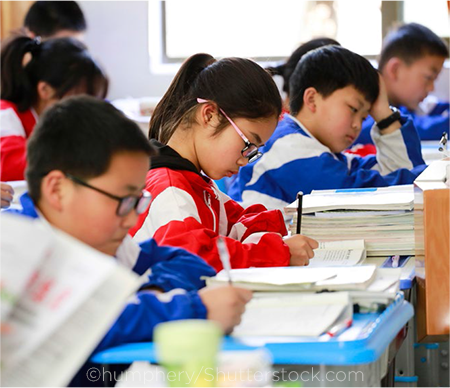Download PDF
In the first year of a two-year study, a once-nightly dose of atropine 0.01% eyedrops slowed the progression of myopia and axial elongation in Chinese children with low and moderate myopia.1 However, given a relatively high rate of loss to follow-up (nearly 30%), additional research is necessary, the researchers cautioned.
 |
PREVALENCE. In China, the prevalence of myopia reaches 5.25% of children by age 6 and exceeds 80% among university students.
|
First in China. This is the first randomized, double-masked, placebo-controlled trial of low-dose atropine in mainland China.
Researchers at Beijing Tongren Hospital enrolled 220 children (age range, 6-12 years) with myopia of –1.00 D to –6.00 D in both eyes. The children were randomized in a 1:1 ratio to receive either 0.01% atropine eyedrops or placebo once each night in both eyes for one year. Refraction and axial length were measured at baseline and at six and 12 months. At the beginning of the second year, the groups were crossed over.
At baseline, mean refractive error was –2.58 D and axial length was 24.59 mm. At one year, myopia progression in the atropine group had declined by a mean of 0.26 D (34.2% reduction) and axial elongation declined by 0.09 mm (22.0%) compared with placebo. No serious adverse events occurred.
Respectable but weak. Ningli Wang, MD, PhD, and his coauthors noted that a 34.2% difference in myopia between atropine and placebo groups was smaller than that observed in a European study.2
In an accompanying commentary, Michael X. Repka, MD, MBA, called the 34% reduction “respectable,” but he noted that the results were less than the 50% reduction hoped for.3 “The best concentration of low-dose atropine eyedrops remains to be determined, but this study suggests to me that a stronger formulation should be considered for a more substantial effect,” said Dr. Repka, at Wilmer Eye Institute in Baltimore.
Dr. Wang agreed. “A reasonable strategy may be to treat initially with atropine 0.01%, then change to a higher concentration if myopia progression continues.”
Dr. Repka also questioned the study’s crossover design, which eliminates the ability to detect multiyear evidence of effectiveness in treating a progressive condition. Dr. Wang, who designed the study, hoped the crossover data might reveal a rebound of myopia after cessation of eyedrops.
Going forward. Trial results from Europe and North America are not expected for at least two years, Dr. Repka said. For now, he advises families interested in atropine treatment to expect to treat for at least two years, with three or four years more likely to achieve a meaningful reduction in myopia progression. He also noted that, in the United States, low-dose atropine is prescribed off-label, requires compounding by a pharmacy, and is not covered by insurance.
—Miriam Karmel
___________________________
1 Wei S et al. JAMA Ophthalmol. Published online Oct. 1, 2020.
2 Sacchi M et al. Acta Ophthalmol. 2019;97(8):e1136-e1140.
3 Repka MX. JAMA Ophthalmol. Published online Oct. 1, 2020.
___________________________
Relevant financial disclosures—Dr. Repka: NEI: S; Dr. Wang: None.
For full disclosures and the disclosure key, see below.
Full Financial Disclosures
Dr. Jeng EyeGate Pharmaceuticals: O; GlaxoSmithKline: C; Kedrion: C; Merck: C.
Dr. Jones University of Utah Research Foundation: P. Callahan SP et al, inventors; University of Utah, assignee. Microscopy visualization. US patent 20140126801 A1. May 8, 2014. Jones BW et al., inventors; University of Utah, assignee. Disease diagnosis and treatment using computational molecular phenotyping. US patent 20130023436 A1. Jan. 11, 2011.
Dr. Pfeiffer None.
Dr. Repka NEI: S.
Dr. Seibold Allergan: C; New World Medical: C.
Dr. Wang Beijing University-CMU: S; Ministry of Science and Technology of the People’s Republic of China: S; National Natural Science Foundation of China: S; Sanming Project of Medicine in Shenzhen: S.
Disclosure Category
|
Code
|
Description
|
| Consultant/Advisor |
C |
Consultant fee, paid advisory boards, or fees for attending a meeting. |
| Employee |
E |
Employed by a commercial company. |
| Speakers bureau |
L |
Lecture fees or honoraria, travel fees or reimbursements when speaking at the invitation of a commercial company. |
| Equity owner |
O |
Equity ownership/stock options in publicly or privately traded firms, excluding mutual funds. |
| Patents/Royalty |
P |
Patents and/or royalties for intellectual property. |
| Grant support |
S |
Grant support or other financial support to the investigator from all sources, including research support from government agencies (e.g., NIH), foundations, device manufacturers, and/or pharmaceutical companies. |
|
More from this month’s News in Review